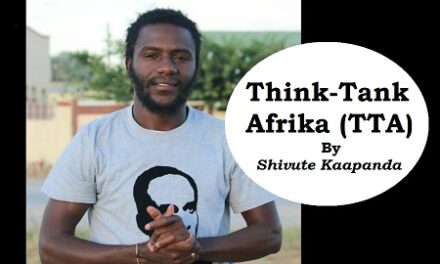Revisiting the Past via Ombaanhu Kingship
By Shivute Kaapanda [Think Tank Africa]
The microscope of legitimacy keep facing the Ombaanhu community now and then due to the lack of proper information about Ombaanhu Kingship and its historical origin.
Following is the sequence of Ombaanhu kings as oral history can recall from the recent generations:
It is said that Amushila waNehau lyaKalimba led Aambaanhu from the great lakes of Kenya. He was not a king nor was he from a particular clan. After settling in the area stretching vast tracts of land in what is today known as Omusati Region, and with the formation of clans, the Aakwanghwiyo/Aakwanambwa clan of Ombaanhu became the royal clan at that time, dominated by members originating from the Nghumbi royal house.
Kamhaku ka-Huhwa was recorded by oral history to be the first king of Ombaanhu kingdom followed by Avula ya-Epohe who was followed by Amuhelo wa-Kalipi followed by Ishitile ya-Ukahona followed by Eita ya-Aitewa followed by Eelu ya-Elaa who was then followed by Avula ya- Alweendo; all these kings were said to belong to the Aakwanghwiyo clan who used to live at ‘Ombala’(palace) designated for Ombaanhu kingship in Ohamwaala village.
History has it that due to the cruelty of king Kamhaku during his reign around 17th century he was as a result burned to death by some of his rebellious servants of Ombaanhu led by an Executor (Ainyaela) around the year 1836.
Kamhaku ka-Huhwa is known to be the founding king of the kingdom of Ombaanhu.
After the brutal death of King Kamhaku kaHuhwa, peace and harmony reigned in the kingdom for many years, so that the next significant historical episode at the palace happened only in the 1900s at the time of colonial infiltration.
Estimated years 1913-1914 King Avula yaAlweendo was the ruler of Ombaanhu. Oral history reveals that King Avula yaAlweendo went with the Germans to Outjo supposedly to sign a protection treaty with the Germans and he was never seen ever since; he was presumed as having disappeared mysteriously, and this brought commotion and fear in the community of Ombaanhu.
Ombaanhu kingdom was thus without a king around 1915 to 1916, but in 1917 the royal clan installed Ishitile yaShiweva also known as ‘Mbwada’ as a king. However there was constant fear for the safety and security of the new King, born of the mysterious disappearance of King Avula yaAlweendo’s incident, as well as the brutal killing of King Mandume yaNdemufayo of Oukwanyama kingdom by the combined forces of British, Afrikaner and Portuguese.
Estimated year 1918, an Afrikaner by the name ‘Cocky Hahn’ who was a commissioner of colonial South Africa arrived in Ombaanhu from Ondonga Kingdom via Uukwambi palace. He was nicknamed ‘Shongola’ in Oshiwambo translated as ‘Whipman’ because he was tall and he used to go around in public with a whip, with which he liked whipping black people as he infamously did with Shiposha sha-Shanyenga in Okapanda village.
It was recorded that Shiposha had in retaliation stabbed ‘Shongola’ in the arm and thereafter Shiposa was banished to Ofafitu ka-Mbindhi near Ogongo in Uukwambi kingdom until his death.
Oral history states that Shongola arrived first at Nauyoma wa-Aipanda’s residence at Okalwii village west of present day Onambelela Combined School. Nauyoma never saw a white person in his life and he was afraid to make conversation with him so that he took the white man to Aipanda ya-Shekwiindi’s residence who was his wife’s relative.
Aipanda ya-Shekwiindi was from Aatundu clan and he welcomed the white man by slaughtering an ox. Aipanda had a lot of cattle from his brother Kalipi ka-Shekwiindi who worked as a spy for Uukwambi king Nuuyoma wa-Eelu and also for Negumbo lya-Kandenge who regularly sent cattle raiders into Ombaanhu kingdom and Uukolonkadhi.
It was during this colonial expansion period and Western agents’ infiltration that the kingdom of Ombaanhu under the kingship of Ishitile ya-Shiweva started to collapse. The royal clan, living in constant fear for their lives as a result of the mysterious disappearance of king Avula ya-Alweendo, started to lose its hold on the throne.
Oral history has recorded that Ishitile ya-Shiweva, who was aware of his weakness in the face of armed colonialists, was an interesting ruler and a man of few words. The most regular answer he gave to any question posed to him was ‘oKalunga’ meaning ‘it is God’. He was very innovative and secretive though, and loved the royal house and wanted to protect it from the influence of white people.
After the whites started to engage the Aambaanhu masses in ways seeking to Westernise, Colonise and Christianise them, King Mbwada expanded his regular answer (in bitterness) adding ‘noonyoko’ so the regular answer became “oKalunga noonyoko”, meaning ‘it is God and your mothers’.
Eventually Shongola engineered the colonial succession of Ombaanhu kingdom which saw Oswin Mukulu and Kaimbi Mundjele taking over a throne unlawfully which Aambaanhu had to take as a remedy to save the royal family from being killed by white people.
The current Ombaanhu Traditional Authority is of a colonial making because it was entrenched by Cocky ‘Shongola’ Hanh in 1918 when he said in Afrikaans language “Van vandag af Kapanda Sekusidi (meaning Aipanda ya-Shekwiindi) is voorman van Ombalanhu” followed by Kaimbi Mundjele and Kalipi Mundjele and Oswin Mukulu the current Chief of Ombaanhu who was elected in the 1980s through the racist apartheid government controlled elections through the Owambo Bantustan government led by Bishop Peter Kalangula deputized by revered Titus Ndatunga Aikanga-Heita.
As a result the Ombalanhu kingdom’s history has been ignored deliberately by the academia, mainstream Namibian media and by the Namibian political leadership since independence.
– Shivute Kaapanda is a pan-African writer, contemporary critic, and author of the book ‘The Conscious Republic’. Email: iskaapanda@gmail.com






